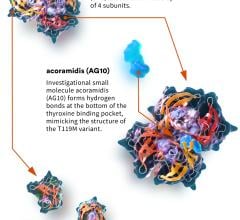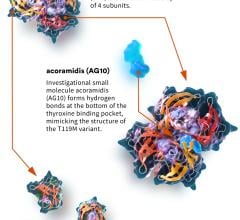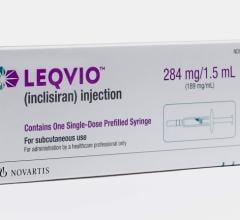June 30, 2011 — Genzyme, a Sanofi company, and Isis Pharmaceuticals Inc. announced today that two additional analyses from phase 3 studies of mipomersen were presented at the 79th European Atherosclerosis Society (EAS) congress.
In a presentation entitled “Mipomersen, A First-in-Class ApoB Synthesis Inhibitor, Lowers Lp(a) in Patients with Heterozygous Familial Hypercholesterolemia (HeFH) and High Baseline Lp(a): Results from two Phase 3 studies,” Elisabeth Steinhagen-Thiessen, M.D., of the Lipid Ambulatory Clinic, University of Berlin, Germany, focused on the effects of mipomersen on elevated lipoprotein(a) (Lp(a)) levels.
Lp(a) is an independent risk factor for heart disease and cardiovascular events. Elevated levels are recognized to have a strong genetic component and are particularly common in people with familial hypercholesterolemia (FH). The EAS consensus panel recommended screening and treatment for elevated Lp(a) in 2010, and the U.S.-based National Lipid Association (NLA)’s expert panel on FH published guidance this year noting that having elevated Lp(a) levels places FH patients at very high cardiovascular risk.
Data from two randomized, placebo-controlled phase 3 trials in patients with HeFH showed that mipomersen reduced Lp(a), LDL-C, and other measures of atherogenic lipoproteins when added to existing lipid-lowering therapy. One study included 124 HeFH patients with coronary artery disease (CAD), and the other included 58 severe HeFH patients. All of the patients were already taking a maximally tolerated dose of a statin, as well as additional lipid-lowering drugs in most cases. Both trials met all of their primary, secondary and tertiary endpoints. In these trials, mipomersen decreased LDL-C by 28 and 36 percent compared with increases of 5 and 13 percent for placebo, respectively (both p<0.001), meeting primary endpoints in both studies.
In addition to evaluating percent reduction in LDL-C as their primary endpoints, both trials also evaluated percent reduction in Lp(a) as tertiary endpoints. Most patients in the two trials (71 and 62 percent) had elevated Lp(a) levels >20 mg/dl at baseline. Mipomersen decreased Lp(a) by a median 21 and 39 percent, compared with zero and five percent for the placebo groups (both p<0.001). Mipomersen lowered Lp(a) by ? 50 percent in 22 percent of mipomersen patients across both studies. The reductions observed were in addition to those achieved with the patients’ existing therapeutic regimens. Additional detail from these studies was presented at the European Society of Cardiology’s congress last year and the American College of Cardiology’s 60th Annual Scientific Session this year.
In a presentation entitled “Mipomersen, an ApoB Synthesis Inhibitor, Might Reduce Necessity for Lipid Apheresis in CAD,” K.G. Parhofer, M.D., of Ludwig-Maximilians University, Munich, Germany, focused on mipomersen’s potential to reduce the necessity for lipid-apheresis by lowering LDL-C values below thresholds for apheresis eligibility. Patients with severe forms of FH may be eligible for this treatment, a dialysis-like procedure where blood is filtered through a machine to remove excess cholesterol. Country-specific LDL-C thresholds to determine eligibility for apheresis can range from ? 100 mg/dL to ? 160 mg/dL. However, many eligible patients are not on apheresis because of lack of availability, high cost and negative impact on quality of life.
In the phase 3 trial in HeFH patients with CAD, an additional analysis revealed that mipomersen reduced the percentage of patients with LDL-C levels ? 160 mg/dL by 95 percent (from 39 percent to 2 percent); with LDL-C levels ? 130 mg/dL by 74 percent (from 62 percent to 16 percent); and with LDL-C levels ? 100 mg/dL by 45 percent (from 98 percent to 54 percent). The reductions observed were in addition to those achieved with the patients’ existing therapeutic regimens. No significant changes in LDL-C were observed in placebo-treated patients.
“These results suggest that the impact of mipomersen on the treatment landscape could be quite significant, both in countries such as Germany, where apheresis is more widely available and the eligibility threshold is relatively low, and in places like the United States, where apheresis is not as widely available,” said Parhofer. “Mipomersen has the potential to reduce the necessity for apheresis in a considerable number of patients, and also become an important new treatment option for those who are eligible for apheresis but cannot access it or tolerate its impact on their quality of life.”
Genzyme expects to file for EU marketing approval of mipomersen for the treatment of patients with homozygous (Ho) FH and severe HeFH early in the third quarter of this year. Genzyme also expects to file for U.S. approval for the HoFH indication in the second half of this year.
Genzyme and Isis have completed the four phase 3 studies that are planned to be included in the initial U.S. and EU filings. As previously reported, the phase 3 study of mipomersen in HoFH patients met its primary endpoint with 25 percent LDL-C reduction, and the phase 3 study in patients with high cholesterol at high risk for coronary heart disease met its primary endpoint with a 37 percent LDL-C reduction. These studies also met all of their secondary and tertiary endpoints, which included percent reduction in Lp(a).
In the four studies, the most commonly observed adverse events were injection site reactions and flu-like symptoms. Persistent elevations in liver transaminases (ALTs) above three times the upper limit of normal (3x ULN) were observed in 8 percent of mipomersen-treated patients across all four studies. Persistent is defined as consecutive elevations at least one week apart. Mipomersen-treated patients who were evaluated by magnetic resonance imaging (MRI) had moderate median increases in liver fat. No patients had changes in other laboratory tests to indicate hepatic dysfunction. In general, increases in ALT levels and liver fat appeared to be associated with rapid and larger drops in LDL-C.
For more information: www.genzyme.com; www.isispharm.com


 February 16, 2024
February 16, 2024 








